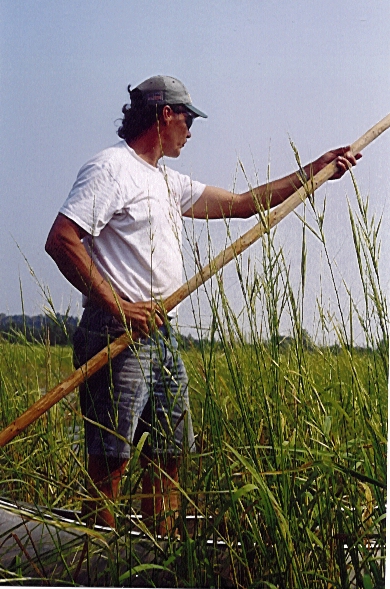Wild Rice Brochures
The students will learn about Wild Rice and how it relates to their culture. It also gives many students a chance to share their personal experience with ricing with the class. A lot of people off-reservation don't know much about the traditions of wild rice and rice harvests. This project is meant for students to share what they know about wild rice in an informative way- through the creation of an educational brochure.
Materials Needed
Resources

Art Materials
Documents
Activity Process
Motivation:
Students will begin my talking about the ricing season on the reservation and what they know about the process. Have they participated?
Demonstration:
Students will go and see the process of harvesting wild rice, learn how to use and make knockers. We will review the process of preparing wild rice since many students have already taken part in the process. To show them how to make the brochures, I will show them different examples of brochures and we will talk about what the various styles have in common. I will ask them what makes them appealing and what the purpose of each type of brochure is (advertising, knowledge, warning, promotion). We will talk about the layouts and arrangements of words, and pictures. After looking at examples and doing some research about different aspects of wild rice, students will try their own brochure.
Activity:
- Students will share their personal experiences with the wild rice process.
- Students will share any Ojibwe language/vocabulary they know related to wild rice.
- Students will have seen demonstrations and have guest speakers to talk to them about the wild rice process.
- Students will view the movie Ojibwe Work: Four films by Monroe Killy, which describes the wild rice process.
- After viewing the movie, I will share different examples of brochures. We will talk about what makes of a brochure and what all have in common with each other. Students will also look at what makes them appealing to read and layout compositions of each.
- When students have an understanding of what a brochure is, we will brainstorm different topics about wild rice that they will want to talk about.
- After brainstorming, students will pick different topics to write about.
- They will receive information from The Great Lakes Indian Fish & Wildlife Commission to help them, along with using information from field trips, guest speakers, movie and personal experiences.
- Students will get a piece of white paper and fold it into three sections.
- They will complete the brochure by writing about the topics they chose, as well as drawing pictures to help explain things.
Closure:
To bring this lesson to a conclusion, students will put their brochures in the hallway to be shared. We will also finish our wild rice unit by making wild rice hot dish and talking about what they thought of the unit. We will also attempt to display the brochures in the community somewhere for all to learn about rice.
Checks:
- The students will be able to list the steps involved in harvesting and processing wild rice.
- The students will be able to say wild rice steps in Ojibwe.
- The students will be able to see how a family works together to harvest and process wild rice.
- The students will show how to use color, line and shape through a brochure.
- The student will be able to make a statement through art.
Vocabulary Words
- Akii-mazina'igan (Map)
- Anishinaabe (Ojibwe)
- Asema (Tobacco)
- Bawa'am (S/he knocks rice)
- Bawa'am bawa'am (Knocking rice)
- Bawa'iganaakoog (Rice knockers)
- Dagwaagin (Fall, autumn)
- Gaandakii'ige (Paddle canoe)
- Gichigami (Sea, Lake Superior, great water)
- Gidasige (Parching rice)
- Jiimaan (Canoe)
- Manoomin (Wild rice)
- Manoominike (Ricing)
- Manoominikeshii (Rice bird (duck))
- Mimigoshkam, mimigoshkam (Dancing on rice)
- Nooshkaachige, nooshkaachige (Fanning the rice)
- Ozhiibwaadenidiwin (Respect)
- Wiigwaasi-makak(oon) (Birchbark container)
- Wiigwassi makakoon (Birchbark basket)
- Wiikonge (Feast)

Comments
The unit and brochures went really well. Students were able to learn and apply Ojibwe language as well as learn the traditional ways of wild ricing. They love sharing their personal experiences about their culture. The overall final products looked very nice.